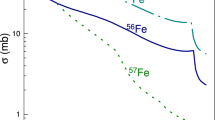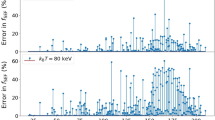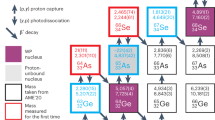Summary
The rapid-proton-capture process is examined in light nuclei starting with22Ne at the neutron star surface. The extreme-density situation prevalent in the neutron star surface requires that the Coulomb term in the equation of nuclear masses is modified. The rise in temperature which may be as high as 108 K and a few times 109 K also is generally due to infall of matter from the binary companion. The Coulomb correction in the nuclear masses affects the proton binding energyQ p in the nuclei. Continuous proton addition in the nuclei depends on theQ p value, which when falls below a certain value will not capture further protons unless the nucleus undergoes β+-decay, thus inereasing the proton binding energy and making the nucleus capable of capturing protons again. The capture path so obtained will be crucially dependent on theQ p value. We have considered the change in the nuclear masses due to this correction effect for the calculation of the proton capture path. We have considered four capture paths forQ p=0.001 MeV, 0.16 MeV, 0.011 MeV and 0.26 MeV. Low-mass nuclei at eachz are formed in the process. They are normally proton rich and undergo β+-decay giving their stable products. It is expected that the stable products of the proton-capturing chain in the neutron star surface may be reflected in the composition of cosmic rays if we subseribe to the view that neutron stars are the source of acceleration of cosmic rays. It is suggested that this rapid-proton-capture process in the neutron star surface may help in understanding some γ-ray burst events associated with the neutron star surface.
Riassunto
Si esamina il processo di cattura rapida del protone in nuclei leggeri partendo con22Ne sulla superficie delle stelle di neutroni. La situazione di densità estrema che prevale sulla superficie della stella di neutroni richiede che il termine di Coulomb nell’equazione delle masse nucleari sia modificata. L’aumento in temperatura che può essere 108 K e alcune volte anche 109 K è generalmente dovuto alla caduta di materia dal compagno binario. La correzione di Coulomb nelle masse nucleari influenza l’energia di legame del protoneQ p nei nuclei. La continua aggiunta di protoni nei nuclei dipende dal valore diQ p, che quando scende sotto un certo valore non cattura ulteriori protoni a meno che il nucleo non subisca decadimento β+, cosí aumentanto l’energia di legame del protone e rendendo il nucleo capace di catturare ancora protoni. Il percorso di cattura cosí ottenuto dipenderà in maniera cruciale dal valore diQ p. Si è considerato il cambiamento nelle masse nucleari dovuto a questo effetto correzione per il calcolo del percorso di cattura del protone. Si sono considerati quattro percorsi di cattura perQ p=0.001 MeV, 0.16 MeV, 0.011 MeV e 0.26 MeV. Nel processo si formano nuclei a piccola massa ad ogniZ. Essi sono normalmente ricchi di protoni e sottostanno a decadimento β+ dando i loro prodotti stabili. Ci si aspetta che i prodotti stabili della catena che cattura protoni nella superficie della stella di neutroni possano riflettersi nella composizione dei raggi cosmici se accettiamo il punto di vista secondo il quale le stelle di neutroni sono la fonte di accelerazione dei raggi cosmici. Si suggerisce che questo processo di cattura rapida di protoni nella superficie della stella di neutroni possa aiutare a comprendere gli eventi di combustione dei raggi γ associati con la superficie della stella di neutroni.
Similar content being viewed by others
References
E. M. Burbidge, G. R. Burbidge, W. A. Fowler andF. Hoyle:Rev. Mod. Phys.,29, 547 (1957).
H. L. Duorah:Indian J. Pure Appl. Phys.,5, No. 4, 111 (1967).
K. Duorah andH. L. Duorah:Phys. Rev.,8, 725 (1973).
J. H. E. Mattanch, W. Thiele andA. H. Wapstra:Nucl. Phys.,67, 1 (1965).
E. Fermi:Nuclear Physics (University of Chicago, Chicago, Ill., 1950), p. 8.
C. D. Cornell:Annu. Rev. Nucl. Sci.,2, 308 (1953).
A. G. W. Cameron:Essays in Nuclear Astrophysics, edited byC. A. Barnes, D. D. Clayton andD. N. Schramm (University of Cambridge, Cambridge, 1982), p. 23.
I. Mazetz, S. Golenetskii, V. Ilynskii, V. Panov, R. Aptekar, Yu. Guruyan, I. Soloskov, Z. Sokolova andT. Karitonova:Astrophys. Space Sci.,80, 3 (1981).
Author information
Authors and Affiliations
Additional information
To speed up publication, the authors of this paper have agreed to not receive the proofs for correction.
Traduzione a cura della Redazione.
Rights and permissions
About this article
Cite this article
Chetia, A., Duorah, H.L. Rapid proton capture in neutron star surface. Nuov Cim B 94, 93–101 (1986). https://doi.org/10.1007/BF02721581
Received:
Published:
Issue Date:
DOI: https://doi.org/10.1007/BF02721581




